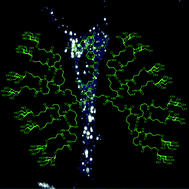Direct solid-phase synthesis and fluorescence labeling of large, monodisperse mannosylated dendrons in a peptide synthesizer†
Abstract
Fluorophore-labeled glycodendrimers have potential use in the study of carbohydrate–

* Corresponding authors
a
Institute of Chemistry, Academia Sinica, 128 Sec. 2 Academia Rd, Nankang, Taipei, Taiwan, R. O. C
E-mail:
dkc@chem.sinica.edu.tw
Fax: +886-2-2783-1237
b Institute of Bioengineering and Nanotechnology, 31 Biopolis Way #04-01, Republic of Singapore (current address), The Nanos, Singapore
c Glycobiologie, Vectorologie et Traffic Intracellulaire, CBM-CNRS, Rue Charles-Sadron, Orleans, Cedex 2, France
Fluorophore-labeled glycodendrimers have potential use in the study of carbohydrate–

 Please wait while we load your content...
Something went wrong. Try again?
Please wait while we load your content...
Something went wrong. Try again?
E. A. B. Kantchev, C. Chang, S. Cheng, A. Roche and D. Chang, Org. Biomol. Chem., 2008, 6, 1377 DOI: 10.1039/B719737C
To request permission to reproduce material from this article, please go to the Copyright Clearance Center request page.
If you are an author contributing to an RSC publication, you do not need to request permission provided correct acknowledgement is given.
If you are the author of this article, you do not need to request permission to reproduce figures and diagrams provided correct acknowledgement is given. If you want to reproduce the whole article in a third-party publication (excluding your thesis/dissertation for which permission is not required) please go to the Copyright Clearance Center request page.
Read more about how to correctly acknowledge RSC content.
 Fetching data from CrossRef.
Fetching data from CrossRef.
This may take some time to load.
Loading related content
